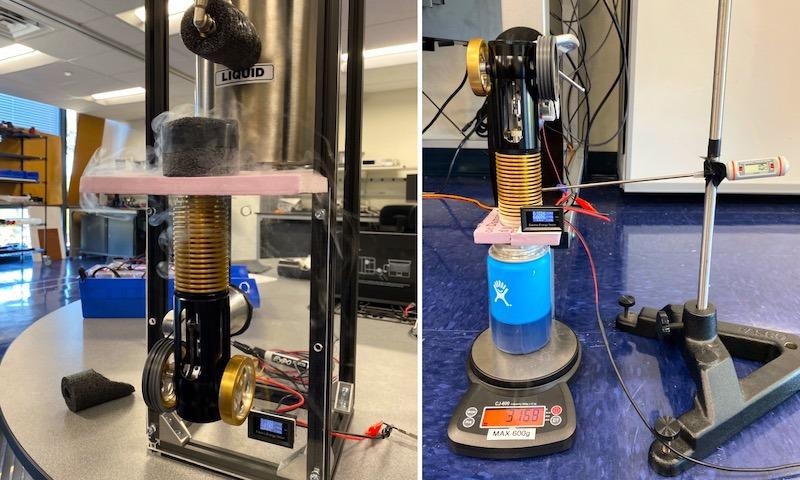Guided by Assistant Professor Tony Pollman, a Naval Postgraduate School team belonging to the Department of Systems Engineering has developed a unique apparatus using a dual-Stirling engine charge and recovery technique for liquid air energy storage (LAES) platforms.
 A provisional patent has been issued for this prototype Stirling dual-engine apparatus constructed by NPS Systems Engineering students Lts. Christopher Girouard and Nicholas Bailey, with the support of advisor Dr. Anthony Pollman. The students’ theses led to this novel approach, using a dual-Stirling engine charge and recovery method for liquid air energy storage (LAES) systems. Image Credit: Naval Postgraduate School.
A provisional patent has been issued for this prototype Stirling dual-engine apparatus constructed by NPS Systems Engineering students Lts. Christopher Girouard and Nicholas Bailey, with the support of advisor Dr. Anthony Pollman. The students’ theses led to this novel approach, using a dual-Stirling engine charge and recovery method for liquid air energy storage (LAES) systems. Image Credit: Naval Postgraduate School.
University graduates U.S. Navy Lts. Christopher Girouard and Nicholas Bailey along with their professor were issued a provisional patent for the apparatus by the U.S. Patent and Trademark Office on February 10th.
“This is a technology that has the potential to shape things we do in life,” said Pollman.
In brief, the dual-Stirling engine is designed to utilize stored surplus energy produced by renewable sources like wind and solar, so it can be used when and where it is required the most. In contrast to other platforms using compressed air energy storage, the NPS team’s innovation would not necessitate large tanks for storage, or the geographical limits that hydro-electric recovery platforms need.
The greatest benefit of this type of energy storage system using liquid air, is that the resource is all around us. It’s free, and has no carbon footprint. And it can be built anywhere. And the Stirling engine is also scalable.
Tony Pollman, Study Lead and Assistant Professor, Department of Systems Engineering, Naval Postgraduate School
In the early 1800s, the Stirling engine’s history started out as a competitor to steam engines. Regrettably, ineffectiveness in the engine’s work cycle rendered the engine incapable of handling a sustained and heavy workload. Therefore, its practical use was mostly confined to low-energy domestic applications.
But, as Pollman quickly noted, the Stirling “is a system that would be used in a micro-grid environment,” he said.
This kind of engine would enhance renewable energy systems which meet curtailment episodes, like hydroelectric, wind and solar panel farms. Curtailment is the decrease of the output of a renewable resource lower than what it can generate.
The two NPS students mentioned in the patent are a few years removed from finishing their NPS studies. Girouard and Bailey are currently working at Naval Shipyards on opposite coasts, and are set to move to new jobs after their two-year Engineering Duty Officer qualification tours at Portsmouth and Puget Sound, respectively.
The news concerning the patent award was a satisfying surprise to them, as they did not hear about its issuance until a technology reporter wrote an article about it from information he collected from the USPTO Gazette for Patents publication.
“Wow! This news was out of the blue,” said Bailey. “To learn that our theses have advanced liquid-air technology a little further is very cool. My mom was very proud of me when she found out.”
Girouard was surprised to learn of the likelihood of a patent for his thesis relating to the Stirling engine research.
I had to ask, is this really going to work? And as we went along, I was really pumped to see how this was going to turn out in our search for an energy storage solution for liquid air. The experience that we had in designing and building the prototype was interesting. Most of the time these [engines] are used to keep highly-sensitive electronic equipment cool rather than generating a phase change for energy storage.
U.S. Navy Lt. Christopher Girouard, University Graduate, Department of Systems Engineering, Naval Postgraduate School
While Girouard was involved in the charging and containment of the system, Bailey was involved in the recovery of the heat exchanger to reduce loss. Another main advantage of this type of energy production is the low maintenance energy needs for the system itself.
Bailey expressed that it was an unbelievable feeling to have the preliminary prototype work.
Chris and I worked for over a year using modeling tools that proved that the system could work, but until we saw it actually turn the engine for the first time, we couldn't be sure. While the initial prototype was inefficient due to design and manufacturing tradeoffs for time, we were able to prove that such an idea had merit and even potential use cases.
U.S. Navy Lt. Nicholas Bailey, University Graduate, Department of Systems Engineering, Naval Postgraduate School
“As for scalability, I believe that for [limited] building size, isolated microgrids, this LAES system could solve resiliency troubles seen with renewable sources like wind or solar energy sources. Such use cases even have some applicability inside the Department of the Navy like small Marine detachments forward deployed away from infrastructure.” Bailey continued.
At present, Bailey is expecting a new set of orders after his two years at Puget Sound Naval Shipyard. Girouard is currently shifting to the Naval Surface Warfare Center, Philadelphia, to be the Program Managers Representative (PMR) for the FFG-62 Land Based Engineering Site, where the team is constructing a propulsion plant for the Constellation Class Frigate to test before the operation of the whole vessel.